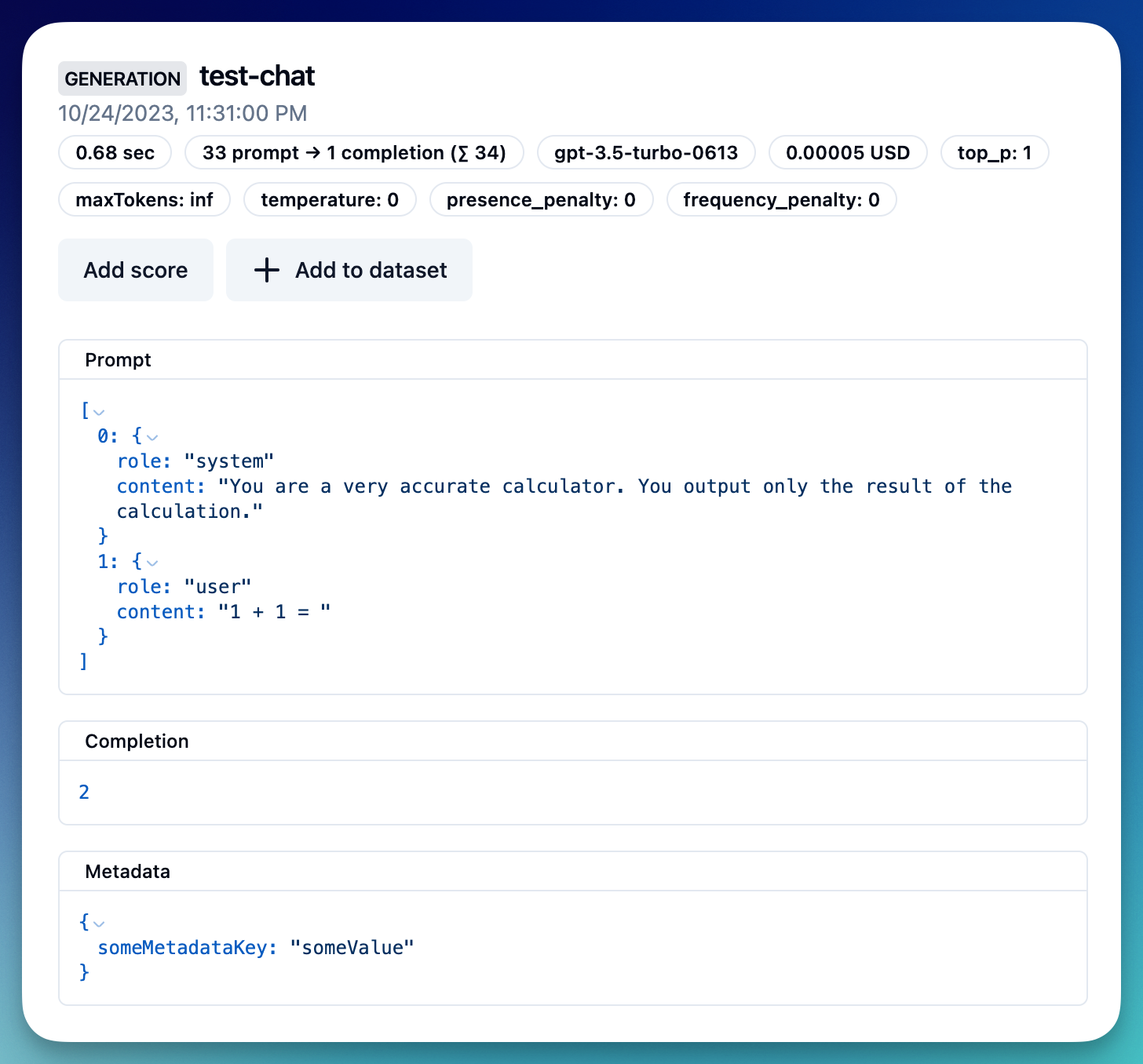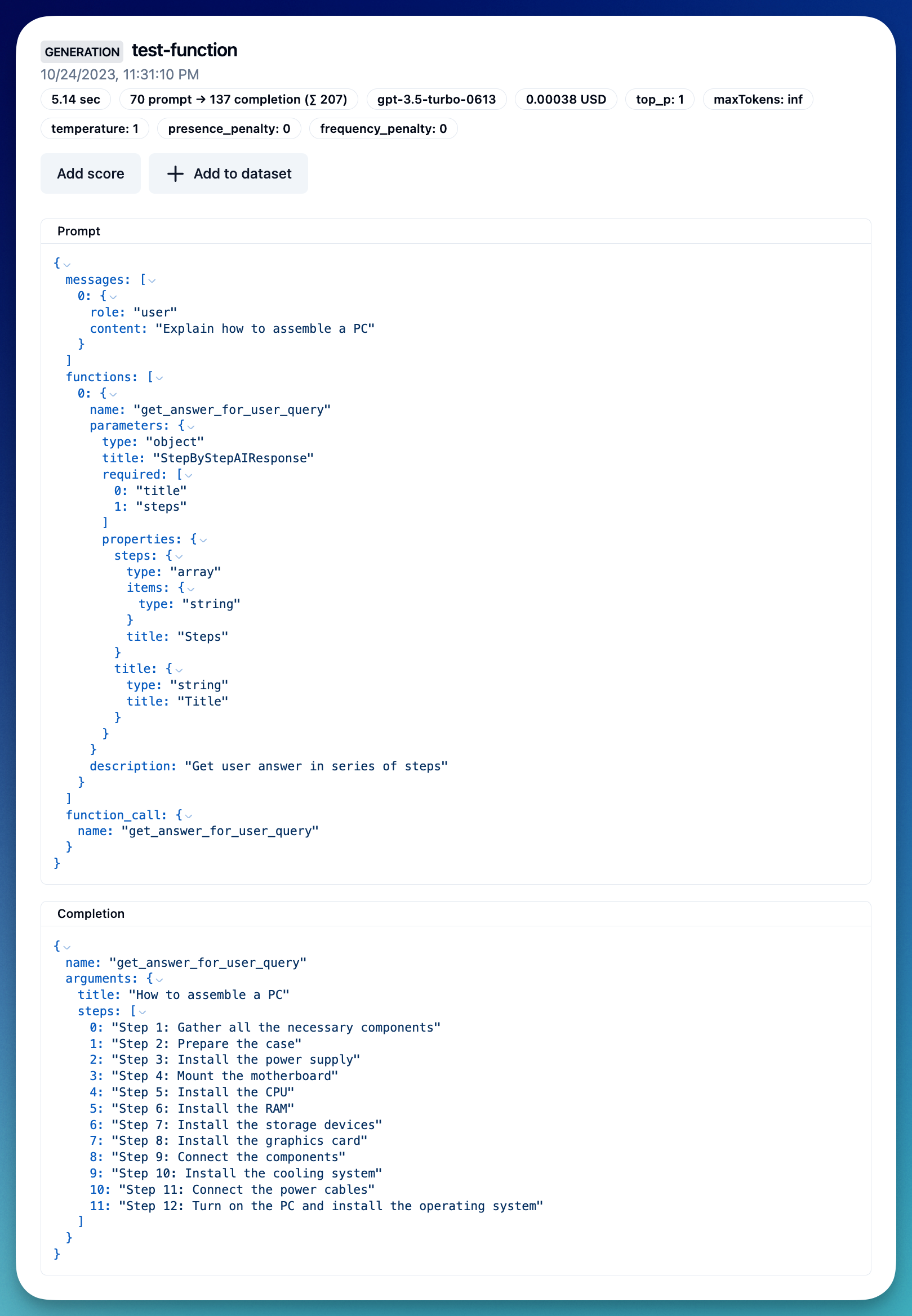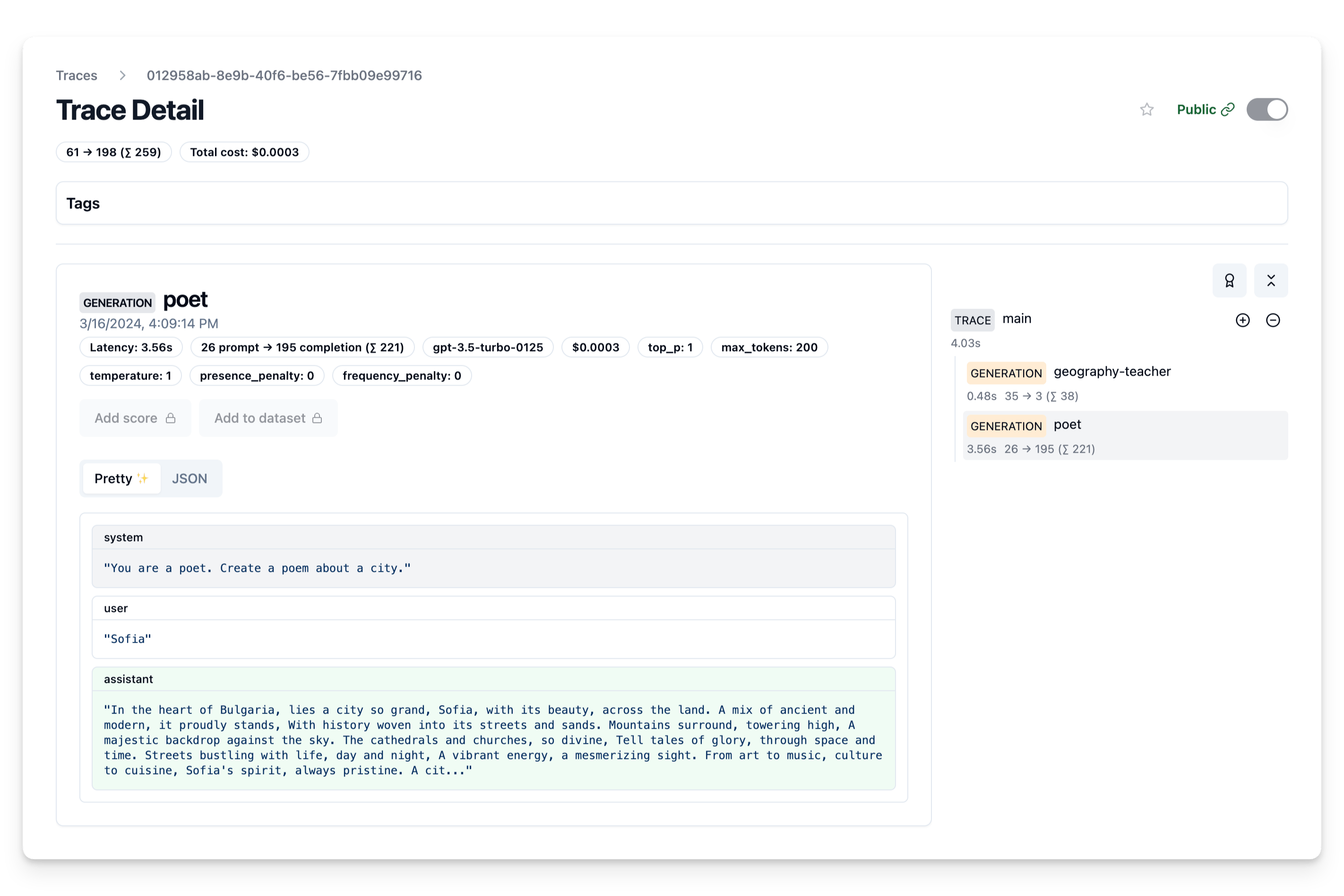Cookbook: OpenAI Integration (Python)
This is a cookbook with examples of the Langfuse Integration for OpenAI (Python).
Follow the integration guide (opens in a new tab) to add this integration to your OpenAI project.
Setup
The integration is compatible with OpenAI SDK versions >=0.27.8. It supports async functions and streaming for OpenAI SDK versions >=1.0.0.
%pip install langfuse openai --upgradeimport os
# get keys for your project from https://cloud.langfuse.com
os.environ["LANGFUSE_PUBLIC_KEY"] = ""
os.environ["LANGFUSE_SECRET_KEY"] = ""
# your openai key
os.environ["OPENAI_API_KEY"] = ""
# Your host, defaults to https://cloud.langfuse.com
# For US data region, set to "https://us.cloud.langfuse.com"
# os.environ["LANGFUSE_HOST"] = "http://localhost:3000"# instead of: import openai
from langfuse.openai import openai# For debugging, checks the SDK connection with the server. Do not use in production as it adds latency.
from langfuse.openai import auth_check
auth_check()Examples
Chat completion
completion = openai.chat.completions.create(
name="test-chat",
model="gpt-3.5-turbo",
messages=[
{"role": "system", "content": "You are a very accurate calculator. You output only the result of the calculation."},
{"role": "user", "content": "1 + 1 = "}],
temperature=0,
metadata={"someMetadataKey": "someValue"},
)Chat completion (streaming)
Simple example using the OpenAI streaming functionality.
completion = openai.chat.completions.create(
name="test-chat",
model="gpt-3.5-turbo",
messages=[
{"role": "system", "content": "You are a professional comedian."},
{"role": "user", "content": "Tell me a joke."}],
temperature=0,
metadata={"someMetadataKey": "someValue"},
stream=True
)
for chunk in completion:
print(chunk.choices[0].delta.content, end="")Chat completion (async)
Simple example using the OpenAI async client. It takes the Langfuse configurations either from the environment variables or from the attributes on the openai module.
from langfuse.openai import AsyncOpenAI
async_client = AsyncOpenAI()completion = await async_client.chat.completions.create(
name="test-chat",
model="gpt-3.5-turbo",
messages=[
{"role": "system", "content": "You are a very accurate calculator. You output only the result of the calculation."},
{"role": "user", "content": "1 + 100 = "}],
temperature=0,
metadata={"someMetadataKey": "someValue"},
)Go to https://cloud.langfuse.com (opens in a new tab) or your own instance to see your generation.

Functions
Simple example using Pydantic to generate the function schema.
%pip install pydantic --upgradefrom typing import List
from pydantic import BaseModel
class StepByStepAIResponse(BaseModel):
title: str
steps: List[str]
schema = StepByStepAIResponse.schema() # returns a dict like JSON schemaimport json
response = openai.chat.completions.create(
name="test-function",
model="gpt-3.5-turbo-0613",
messages=[
{"role": "user", "content": "Explain how to assemble a PC"}
],
functions=[
{
"name": "get_answer_for_user_query",
"description": "Get user answer in series of steps",
"parameters": StepByStepAIResponse.schema()
}
],
function_call={"name": "get_answer_for_user_query"}
)
output = json.loads(response.choices[0].message.function_call.arguments)Go to https://cloud.langfuse.com (opens in a new tab) or your own instance to see your generation.

Group multiple generations into a single trace
Many applications require more than one OpenAI call. In Langfuse, all LLM calls of a single API invocation can be grouped into the same trace.
There are 2 options: (1) pass a trace_id (own or random string) or (2) create a trace with the Langfuse SDK.
Simple: trace_id as string
To get started, you can just add an identifier from your own application (e.g., conversation-id) to the openai calls – or create a random id.
# create random trace_id
# could also use existing id from your application, e.g. conversation id
from uuid import uuid4
trace_id = str(uuid4())
# create multiple completions, pass trace_id to each
country = "Bulgaria"
capital = openai.chat.completions.create(
name="geography-teacher",
model="gpt-3.5-turbo",
messages=[
{"role": "system", "content": "You are a Geography teacher helping students learn the capitals of countries. Output only the capital when being asked."},
{"role": "user", "content": country}],
temperature=0,
trace_id=trace_id
).choices[0].message.content
poem = openai.chat.completions.create(
name="poet",
model="gpt-3.5-turbo",
messages=[
{"role": "system", "content": "You are a poet. Create a poem about a city."},
{"role": "user", "content": capital}],
temperature=1,
max_tokens=200,
trace_id=trace_id
).choices[0].message.contentGo to https://cloud.langfuse.com (opens in a new tab) or your own instance to see your trace.

Fully featured: interoperability with Langfuse SDK
The trace is a core object in Langfuse and you can add rich metadata to it. See Python SDK docs (opens in a new tab) for full documentation on this.
Some of the functionality enabled by custom traces:
- custom name to identify a specific trace-type
- user-level tracking
- experiment tracking via versions and releases
- custom metadata
from langfuse import Langfuse
# initialize SDK
langfuse = Langfuse()
# create trace and add params
trace = langfuse.trace(
# optional, if you want to use your own id
# id = "my-trace-id",
name = "country-poems",
user_id = "user@example.com",
metadata = {
"env": "development",
},
release = "v0.0.21"
)
# get traceid to pass to openai calls
trace_id = trace.id
# create multiple completions, pass trace_id to each
country = "Bulgaria"
capital = openai.chat.completions.create(
name="geography-teacher",
model="gpt-3.5-turbo",
messages=[
{"role": "system", "content": "You are a Geography teacher helping students learn the capitals of countries. Output only the capital when being asked."},
{"role": "user", "content": country}],
temperature=0,
trace_id=trace_id
).choices[0].message.content
poem = openai.chat.completions.create(
name="poet",
model="gpt-3.5-turbo",
messages=[
{"role": "system", "content": "You are a poet. Create a poem about a city."},
{"role": "user", "content": capital}],
temperature=1,
max_tokens=200,
trace_id=trace_id
).choices[0].message.contentYou can also use the nesting capabilities of Langfuse Tracing by providing a parent_observation_id. For example, this can be the id of a span that you created via the Langfuse Python SDK.
Add scores to generation
You can also add scores (opens in a new tab) to the trace, to e.g. record user feedback or some other evaluation. Scores are used throughout Langfuse to filter traces and on the dashboard. See the docs on scores for more details.
The score is associated to the trace using the trace_id (see previous step).
from langfuse import Langfuse
langfuse = Langfuse()
langfuse.score(
trace_id=trace_id,
name="my-score-name",
value=1
);Go to https://cloud.langfuse.com (opens in a new tab) or your own instance to see your trace with score.
